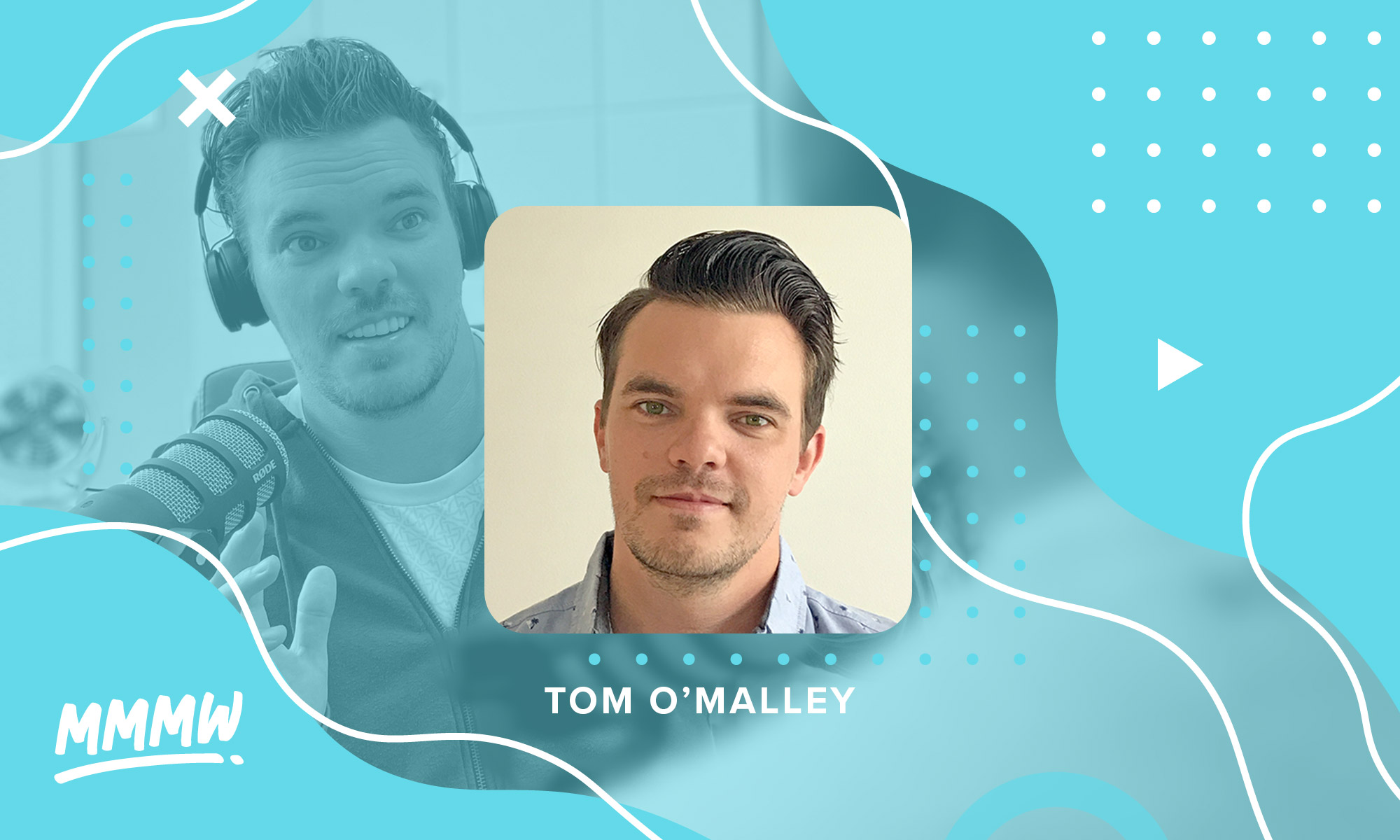Burning Freelancer Questions (1st Edition)
Episode 3
In this episode of MMMW, I’m answering five burning questions from real people about running a creative freelance business. We get into passive income streams, the future of web design, side hustle ethics, WordPress themes, and finding high-paying clients. No matter what stage of the freelance journey you’re on, chances are, you’ve asked yourself these same questions. Download now for my take on some of the internet’s most common inquiries!
Be sure to subscribe via your favorite podcast player and (of course) your ratings & reviews would mean the world to me!
Links from the Episode
Transcript
TOM O’MALLEY: Hey there, fellow freelancers. You’re listening to Tom with Making Money Making Websites and today I’m answering some burning questions from real people about running a web design business. Let’s get it going!
[ INTRO MUSIC ]
Welcome to triple-M W, y’all; You should know by now, I make an effort to keep my finger on the pulse of the freelance ecosystem. Browsing social media and various forums over the years, I’ve seen some great questions come up time and time again. Eventually, I’d love to set up a voicemail box for my listeners to record their own inquiries to be featured on episodes like this. For now, I’ve just borrowed some questions from around the web. Here we go…
Question 1: Camille asks Twitter, “Freelance friends with passive income streams; how did you get started and what’s the most useful thing you’ve learned?”
Ya know, passive income is such a buzzword in the online marketing space. Everyone loves the idea of “mailbox money”—just collecting cash while you sleep. I’ve been following Pat Flynn and his Smart Passive Income journey for many years. You’d think given the name of his site, he’d be sitting on a beach in the Bahamas checking his email once a month while he waits for the cleaning cycle on his piña colada machine to finish. But no, that dude is one of the hardest working hustlers in the game. Literally the opposite of passive. Hey, I get why we idealize this concept of automated revenue. I just don’t think it exists in the sense we all hope. It takes a TON of time and hard work to build systems that generate income on their own. Sure, you might be able to take a week or two off while sales roll in, but it likely won’t last forever on autopilot. With that said, do passive income streams exist in the freelance web design world? Kinda! Website hosting is a popular route to take. Of course I don’t expect you to fill your spare bedroom with racks of servers. You get yourself a flexible hosting plan and allow your clients to host thru you for a monthly or annual fee. You can charge anywhere from $10-40/month for this convenience. As you launch more and more sites, that number can really add up to something meaningful. I make about $785 each month in recurring revenue from hosting alone. It’s about as close to “passive” as you can get. Don’t forget you could do this with other services too. Any SaaS platform that offers significant bulk discounts can be a profit opportunity for you and value added for your clients. Or if you happen to be a well-versed developer yourself, selling plugins, extensions, and apps can also be quite lucrative—and you won’t have to share revenues with anybody. Lastly, affiliate marketing might make sense for a web designer. Align yourself with tools and services your clients commonly need. When your recommendation leads to a sale, you get a kickback. Be careful here. It can come across a little grimey to email a client what is clearly an affiliate link and tell them to buy. I do very little of this myself but it’s an option. To recap, reselling hosting is your best bet—but I still stand by totally “passive income” being a bit of a myth. The real money in freelance web design… is freelance web design.
Question 2: Mark asks Quora, “Is the web design industry dead?”
WOW, Mark… just wow. Way to bring the room down, man. OK, so I kinda see what he’s getting at here. Big picture—like WAY zoomed out, 20-year forecast, I do believe the web design industry as it exists today will look quite different. Part of that is due to an increase in digital proficiency. We’re already battling against platforms like Wix and Squarespace that spend millions each year trying to convince the average entrepreneur they can make their own site for free in just a few hours. More sophisticated no-code apps, like Webflow, take that promise to a whole new level. I’ve actually brought it up to a few colleagues in the past; this lingering fear that what I do will someday become obsolete. If normies can make websites, I’m screwed. The reality is, though, any business owner who thinks they can launch a legitimate online presence without spending money would be the worst kind of client anyway. Bottom feeders. Let ‘em use Geocities. One of two things will happen: They’ll either, A) publish a rinky dink site for pennies and be perfectly content with mediocrity—or, B) realize they need to focus on growth & operations and leave the creative stuff to professionals like us. Real companies are always gonna prefer hiring out. Pepsi is never gonna put their brand in the hands of a page builder they saw a TV commercial for. This doesn’t mean us web designers are safe being stagnant. You should always be learning, upskilling, staying ahead of what’s next. Websites aren’t going anywhere but they will evolve from both a design and technology perspective. Take responsive templates for instance. A single site, adapting seamlessly to any device. It literally didn’t exist 10 years ago and now it’s absolutely expected with every new project. The web design industry is just getting started. Our job is to stay ahead of it while working inside of it.
Question 3: Bryce asks Reddit, “Am I still allowed to take on freelancing projects while working at another agency?”
This is a HUGE question; one that’s probably on a lot of your minds. It’s just a reality that most freelancers are not full-time. They use it to supplement their 9-to-5 income. And before I get myself in trouble here, just remember, I’m not a lawyer. Nothing I ever say should be interpreted as sound legal advice. Please don’t use me as your one call from prison. Alright so, at the very top level of this debate, we should note that Bryce is employed by an agency. Context matters, folks. I don’t think the ethical conundrum would exist as much if he worked at McDonald’s. The fact that he’s with a company that offers the same services he does (presumably at higher prices) complicates things immensely. First and foremost, is there an employee contract or agreement you signed when you were hired? Does it mention a policy on freelancing or competition? In any of the binders of nonsense you were given on your first day, does it talk about this stuff? For the sake of this conversation, let’s assume no. The last agency I worked for was very casual—nothing like that in black & white. No employee handbook or bylaws or anything. However, I still found myself in the same moral dilemma as Bryce. I had a great new gig with regular paychecks and benefits and all that, but also my ongoing freelance activity didn’t just disappear magically. What did I do? I created my own policy to abide by: If a lead or client originated from my day job, it stayed there. Non negotiable. BUT if freelance opportunities came to me through old contacts or friends or whatever, I would handle it on the side. That seems pretty fair, right? Poaching definitely isn’t cool and it’s surely (at least) a fireable offense. In Bryce’s post, a few people commented that he should sit down with his boss, be upfront about wanting to freelance on his own time without jeopardizing his J-O-B in any way. Yea, sounds like something Danny Tanner would do—but there’s no way it ends with their blessing. Even if they aren’t worried about you stealing clients, they won’t love the idea of your billable waking hours being spent elsewhere. Whether you’re working on freelance projects during the day or exhausted from working on them at night, it’s a threat to them squeezing every last ounce of productivity out of you. Bosses want you to earn for them and cease to exist otherwise. I’ll keep this old saying PG-rated, but don’t poop where you eat. If you care about your job, use your noggin. Obviously, I’m all for a little side-hustle, but keep it as separate as possible. I’ve been able to maintain my freelance game through several jobs without issue. I’ve also been fired for it once or twice. If you ask me, don’t steal time; don’t steal clients; do good work—and your extracurricular endeavors are your own dang business.
Question 4: Paul asks LinkedIn, “Is there one WordPress theme that can handle all my freelance projects?”
Back in the beginning, when I would land a new client—let’s say a church… I would actually browse Themeforest and TemplateMonster for a pre-built CHURCH theme. For most industries, a specialized theme already exists out there. Restaurants, medical practices, whatever. I thought it gave me a real head start. This wasn’t a sustainable method, though, and here’s why: 1) these niche themes, although beautiful, are not exactly the cream of the crop. Many of them hard-code so much of the template that it can be difficult to meet any customization requests your client may have. Not to mention, they don’t tend to be improved and updated as often as more popular ones—which can also increase the chances of them breaking with new WordPress or plugin releases. 2) when you start to accumulate several clients, you don’t want to be totally lost in WP Admin world every time they request a change down the road. Having to re-learn a theme’s quirks and controls is not an efficient way to run your business. So Paul’s question is a good one, and it’s one I’m very glad I asked myself a few years ago. There are absolutely a handful of all-in-one themes out there that can be easily manipulated to fit any purpose. Flexible, modular themes with robust page builders. To name a few, we have Divi, Enfold, BeTheme, X, Astra, and Total. They all have optional pre-built templates and dummy content if you don’t wanna start from scratch. Personally, I use Astra on occasion (it’s considered one of the fastest out there, and it’s great for e-commerce) but my go-to 99% of the time is Enfold, by far. It may not have all the bells and whistles some of the fancier ones do, but I rarely see a design I couldn’t pull off in ol’ trusty Enfold. My recommendation to Paul (and all of you): try them all, pick the one you’re most comfortable with, and completely immerse yourself in it. Learn every single nook and cranny. Eat, sleep, play, and DREAM about it. The better-versed you are in that theme, the faster you can whip websites together, get paid, and move onto the next.
Question 5: Emma asks Facebook, “How do I find high-paying clients?”
Emma, this question is too big for one little podcast episode. This question is too big for one QUESTION! I mean, I’m not oblivious to what my followers really wanna know. They’re willing to sift through years of blog articles, stalk my social media, and listen to hours of me rambling for a glimmer of the secret, right? Where do we find CLIENTS? Let me just put this out there right now; I know a hundred ways to get web design leads—and I’m more than willing to share every last one of them. But at the end of the day, what actually matters is your quality of work and level of service. Listen carefully; clients lead to clients. I’m not even talking about referrals necessarily. I’m talking about good work naturally propelling your business forward. Getting those first 5 clients is BRUTAL, but believe me when I say this machine will start to move for you shortly after. Before I wrap this subject up for now, I wanna be sure to address the qualifying statement in Emma’s question, “high-paying” clients. Are there freelancers out there whose books are stacked with high-paying clients? Yes. How? They said no to the low-paying ones.
Now instead of promoting a sponsor for today’s episode, I would much rather encourage you to visit MMMW.CO right away and join my mailing list. It’s on every page – you can’t miss it. Many of my most lucid thoughts and valuable tidbits are sent via email. Totally free, tons of value, and never too often. You will not regret it! Go to MMMW.CO and subscribe today.
Thanks SO much for listening. Episode three is officially in the rear view. Have you noticed this microphone picks up my slight lisp without fail? That’s fun! Follow along for some epic rants about the in’s and out’s of freelance web design as well as interviews with real people who are killing it on both the business and creative side of things. For notes and extras of today’s episode, head on over to mmmw.co/listen/3. Until next week, fellow freelancers!
[ OUTRO MUSIC ]
About the Podcast
Embrace the freelance life and make your future happen faster with expert insights and deep-dive interviews about the business side of web design.
Meet Your Host
Tom O’Malley is a successful freelance web designer based in Charleston, SC. In nearly two decades of building websites, Tom has proudly served clients big and small across dozens of industries—earning over $1 million with his creative side hustle.
Making Money Making Websites
Available wherever you listen




